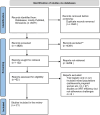Barriers to ART adherence in sub-Saharan Africa: a scoping review toward achieving UNAIDS 95-95-95 targets
- PMID: 40556913
- PMCID: PMC12185539
- DOI: 10.3389/fpubh.2025.1609743
Barriers to ART adherence in sub-Saharan Africa: a scoping review toward achieving UNAIDS 95-95-95 targets
Abstract
Introduction: With the 2025 UNAIDS 95-95-95 deadline upon us, significant gaps remain in achieving universal HIV care and treatment targets, particularly in Sub-Saharan Africa. Despite years of intensified global efforts, progress has lagged, partly driven by the multifaceted challenges of non-adherence to ART, shaped by social, economic, structural, and individual factors. These challenges have been compounded by the ever-changing landscape of global HIV funding, further undermining treatment outcomes. Addressing these interconnected barriers is essential to identify and implement targeted, evidence-based solutions.
Methods: To explore these challenges and potential interventions, a scoping review was conducted, searching through PubMed and Dimensions databases for peer-reviewed articles published from 2020 through February 2025. Eligible studies focused on barriers to ART adherence in adult men and women ≥ 18 years old living with HIV, aligning with the UNAIDS 95-95-95 framework in sub-Saharan Africa.
Results: Of the 4,928 articles screened, 21 were included in this scoping review. Although the search period was extended to February 2025, no eligible studies published in 2025 were identified. Barriers to ART adherence were multifaceted, spanning individual-level issues such as mental health issues and substance abuse; social barriers including stigma and intimate partner violence; and economic factors, including food insecurity, transport costs, and income instability. Structural barriers such as health system fragmentation, clinic accessibility, and drug stockouts were also common and often worsened by the COVID-19 pandemic, which disrupted service delivery and exacerbated socioeconomic vulnerabilities. While only peer-reviewed articles were included in the analysis, recent UNAIDS reports and reputable media sources, such as The Guardian, were referenced to contextualize the emerging impact of the 2025 HIV funding cuts, which have not yet been reflected in the academic literature.
Conclusion: Our findings emphasize the urgent need for targeted, multi-level interventions to address persistent economic, social, psychological, and policy barriers to ART adherence. A sustainable funding framework, combined with financial support, mental health services, and community-based care models, is crucial for improving retention and long-term adherence. These insights are essential for shaping policies, strengthening HIV service delivery, and sustaining momentum toward the 95-95-95 targets amid systematic challenges.
Keywords: 95-95-95 UNAIDS; ART adherence; HIV/AIDS; adult men and women; global HIV funding.
Copyright © 2025 Magura, Nhari and Nzimakwe.
Conflict of interest statement
The authors declare that the research was conducted in the absence of any commercial or financial relationships that could be construed as a potential conflict of interest.
Figures


Similar articles
-
Barriers and facilitating factors to the uptake of antiretroviral drugs for prevention of mother-to-child transmission of HIV in sub-Saharan Africa: a systematic review.J Int AIDS Soc. 2013 Jul 19;16(1):18588. doi: 10.7448/IAS.16.1.18588. J Int AIDS Soc. 2013. PMID: 23870277 Free PMC article.
-
HIV care and treatment experiences among female sex workers living with HIV in sub-Saharan Africa: A systematic review.Afr J AIDS Res. 2016 Dec;15(4):377-386. doi: 10.2989/16085906.2016.1255652. Afr J AIDS Res. 2016. PMID: 27974017 Free PMC article.
-
Behavioral interventions to reduce risk for sexual transmission of HIV among men who have sex with men.Cochrane Database Syst Rev. 2008 Jul 16;(3):CD001230. doi: 10.1002/14651858.CD001230.pub2. Cochrane Database Syst Rev. 2008. PMID: 18646068
-
Magnitude and characteristics of unsuppressed HIV viral load in children and adolescents on antiretroviral therapy in sub-Saharan Africa: a systematic review and meta-analysis.Lancet HIV. 2025 Jul;12(7):e506-e521. doi: 10.1016/S2352-3018(25)00039-6. Epub 2025 Jun 2. Lancet HIV. 2025. PMID: 40473447
-
Structured treatment interruptions (STI) in chronic unsuppressed HIV infection in adults.Cochrane Database Syst Rev. 2006 Jul 19;2006(3):CD006148. doi: 10.1002/14651858.CD006148. Cochrane Database Syst Rev. 2006. PMID: 16856117 Free PMC article.
References
-
- UNAIDS . (2021). Political declaration on HIV and AIDS: ending inequalities and getting on track to end AIDS by 2030 | UNAIDS. Available online at: https://www.unaids.org/en/resources/documents/2021/2021_political-declar... (Accessed: 29 March 2025).
-
- UNAIDS (2017). Progress towards the 90-90 targets ending AIDS GLOBAL AIDS UPDATE. Available online at: https://www.unaids.org/en/resources/documents/2017/20170720_Global_AIDS_...
-
- UNAIDS . (2024) ‘UNAIDS results in eastern and southern Africa 22–23’. Available online at: https://www.unaids.org/en/resources/documents/2024/global-aids-update-2024 (Accessed: 7 May 2025).
-
- Pilgrim N, Musheke M, Raymond HF, Keating R, Mwale J, Banda L, et al. Quality of care and HIV service utilization among key populations in Zambia: a qualitative comparative analysis among female sex workers, men who have sex with men and people who use drugs. AIDS Care. (2019) 31:460–4. doi: 10.1080/09540121.2018.1524119, PMID: - DOI - PubMed
Publication types
MeSH terms
Substances
LinkOut - more resources
Full Text Sources
Medical

